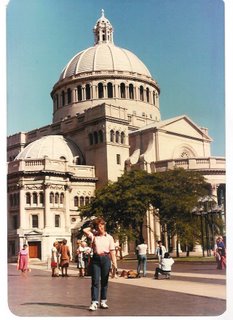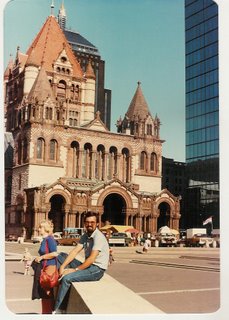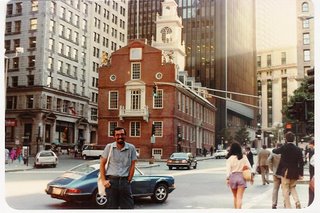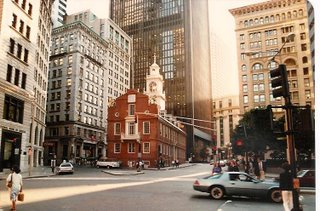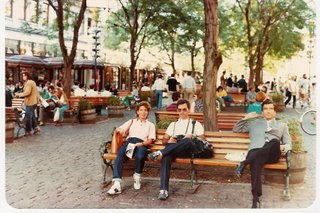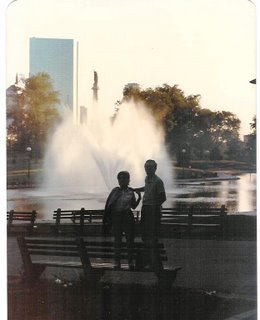QUEBÉC HAUTE VILLE
I was wondering whether to post this in English or in French. I decided to combine both: the introduction will be in French, and the sub-titles to the photos will be in English. Anyhow one can always use the automatic translation systems to read it, even if the results are sometimes very, very abnormal...
***
Après la Nouvelle Angleterre, on est entré au Canada par la Province du Québec et le premier arrêt a été à la capitale, la Ville de Québec.
La ville de Québec, la plus vieille ville francophone d'Amérique - «
le berceau de l'Amérique française» -, est la seule ville fortifiée du continent au nord du Mexique et a été déclaré site du patrimoine mondial par l'UNESCO en 1985, après notre visite... Il semble qu'elle est la seule a avoir cette distinction en Amérique du Nord.
Le nom Québec dérive du mot algonquin Kébec, qui signifiait «là où le fleuve se rétrécit» et dénommait la faible largeur du fleuve Saint-Laurent entre les lieux où les villes de Québec et de Lévis, sur la rive opposée, ont été crées. La ville de Québec a été officiellement fondée par Samuel de Champlain le 3 juillet 1608 et de 1608 à 1627 et de 1632 à 1763, elle a été la capitale du Canada et de toute la Nouvelle-France. La ville de Québec va donc célébrer ses 400 ans en 2008, ce que la permet d’être surnommée la vieille Capitale. En plus, il semble que cet anniversaire mobilise des millions de dollars pour les événements et les nouvelles infrastructures annoncés. On verra...
La ville de Québec a une topographie particulière, constituée d'une part de la falaise ceinturant le plateau La Cité-Sainte-Foy-Sillery et d'autre part du coteau de Beauport, ce qu’a fortement influencé l'occupation du territoire. Sur le plateau, la succession des quartiers depuis le Vieux-Québec vers l'ouest permet comprendre la constitution progressive de la Haute-Ville, dénomination que trouve toute sa signification par opposition à la Basse-Ville, qui s'est développée au pied de la falaise nord et au contact direct du fleuve Saint-Laurent.
***



"PLAINS OF ABRAHAM - the land that Abraham Martin, named L'Écossais, never owned or even lived on, but used instead to graze his cattle - was the site of the September 13, 1759 final battle for supremacy between the French and British Empires in the North American theatre of the Seven Years' War. Combat lasted only 30 minutes, ending a three-month siege of the fortified town, and open the way to the conquest of New France by Britain. Both the French General Louis-Joseph de Montcalm-Gozon, Marquis of Montcalm, and the British General James Wolfe were killed in the battle that changed the fate of North America. Today, the Battlefields Park, further to its historical meaning, is the lungs of Quebec City. In the background one can see the Quebec Parliament as well as some other buildings belonging to the local Government"

"DRILL HALL - The building at the National Battlefields Park is beautiful, with the turrets flanking the entrance"

"LAMP - The lamp in the Park looks quite similar to some we use to have in the old quarters of Lisbon"

"CITADELLE - The Citadelle of Québec City (the Gibraltar of America) is a national historical site and the official residence of the Governor General. The first protective wall was built in the 17th century under Louis de Buade, sieur de Frontenac, after a plan of fortifications was approved by Louis XIV's commissary general of fortifications Sébastien Le Prestre de Vauban in 1701. The existing star-shaped fortifications were built by the British between 1820 and 1831 and the home of the Royal 22nd Regiment, the French-speaking regiment of Canadian Forces"

"AVENUE ST. DENIS with the Chateau Frontenac Hotel in the background"


"PLACE D'ARMES - Located in front of the Chateau Frontenac hotel, the Place d'Armes was in the past the site for military parades and drills. In the early 1900s, the Place was re-opened as a public park and it's nowadays one of the highlights of the Vieux Québec. The Monument of Faith, a sculpture commemorating the arrival of Recollet Mona from France in 1615, can be seen in the centre of the park. The only problem was that this summer morning was a bit rainy..."


"STATUE OF SAMUEL DE CHAMPLAIN - CHAMPLAIN (1567 - 1635), a French explorer, who founded Quebec City, and thus earned the nickname «Father of New France», arrived to the banks of the Saint-Laurent and Saint-Charles rivers some seventy years after another French explorer, Jacques Cartier. After a few early visits to North America, Champlain landed at
Kébec on July 3, 1608, and constructed three buildings, as well as a 5 meter wide moat to protect the area against attack. This was to become the city of Quebec, and fortifying his «Habitation» became a passion for the rest of his life"

"THE CHATEAU FRONTENAC was built between 1893 and 1924 (a new wing seem to have been added in the 1990s after our visit), and it is named after Louis de Baude, Count of Frontenac, a 17th-century governor of New France. Designed by architect Bruce Price, it was one of the first of a long series of «château» style hotels built for the Canadian Pacific Railway company at the end of the 19th and the start of the 20th century. Perched on top of Cap-Diamant, overlooking the Saint-Laurent like an imposing medieval castle, the Frontenac is the archetype of the château-style hotel, with towers, steeply pitched roofs, and dormer windows, and one of Québec City's most famous landmarks. An unmistakable symbol of the city, the hotel hosted many notable names, including Charles De Gaulle, Alfred Hitchcock, Grace Kelly, Prince Rainier, Winston Churchill and Franklin D. Roosevelt. In fact, several summit meetings between Churchill and Roosevelt were held nearby. The Quebec Conference of 1943, in which Winston Churchill and Franklin D. Roosevelt discussed strategy for World War II, was held at the Citadelle while much of the staff stayed nearby at the Château Frontenac. It deservedly is one of the most photographed hotels in the world..."


"THE TERRASSE DUFFERIN is a boardwalk along the edge of the cliff, offering beautiful views of the Saint-Laurent and leading to the stairways of the Promenade des Gouverneurs, clinging to the cliffs beneath the Citadelle. It bears the name of the Governor-general of Canada in the 1870s, Lord Dufferin, when it was created in its present form. Not as much as Portofino or Positano, the
Terrasse has a somehow resort character, and was, anyhow, very fashionable... with a nice view to the Lower Town and across the Saint-Laurent to Lévis on the far bank. A bit wet in the morning, it was much better in the afternoon!"

"SAINT-LAWRENCE AND LEVIS - A lousy, grey photo of a cloudy day!"


"ST. ANNE STREET - Beautiful roofs"

"CITY HALL - The sign means that Quebec City was then commemorating its 375th anniversary. Nice tip to get there next year for the four hundredth commemoration..."

"MUSÉE HISTORIQUE at the corner of St. Anne and Trésor streets, a painless history lesson, and also a wax museum, the Musée de Cire housed in a fine 18th-century dwelling"



"UPPER TOWN STREETS: Quite peaceful; anyhow, look at those cars..."

"LA VIEILLE MAISON DU SPAGHETTI at 625 Grand Allée Est was a nice place to have dinner. It seems that the restaurant is still around and has a
site. They are open seven days a week, and suggest you call ahead for a reservation at (418) 529-6697. Have a nice time..."













































